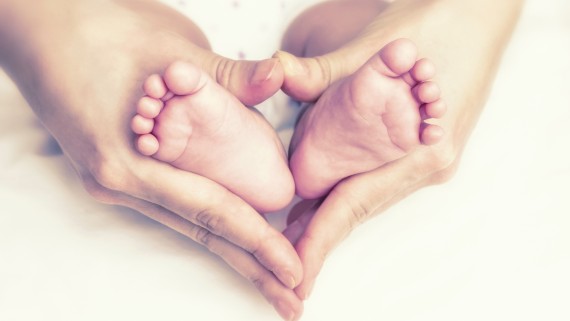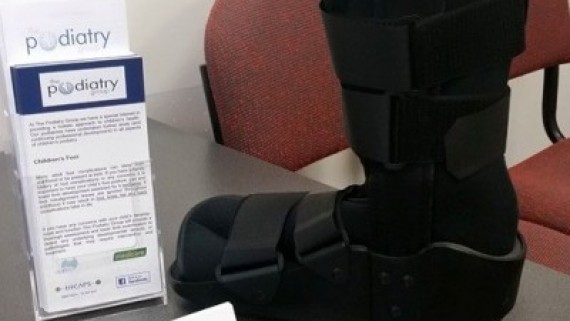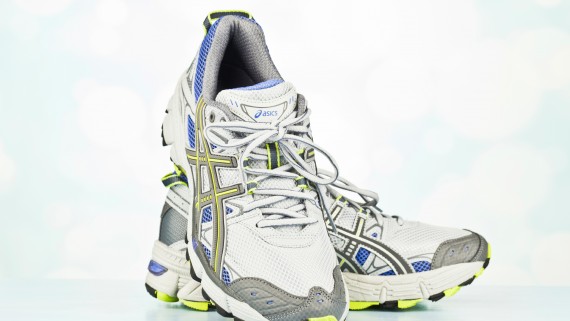Ankle sprains are one of the most common leg injuries that podiatrists treat every day. You can twist an ankle during sport, at work or just minding your own business at home. Whether you have twisted an ankle for the first time or the 10th time, it is a good idea to book an appointment with your podiatrist.
We can help you from start to finish. From a thorough assessment of the damage to the ankle to getting you back on your feet and doing what you love best.
Assessment of ankle sprains is very important, as there may be very little damage to the structures in the ankle or there can be a complicated bone fracture requiring urgent attention. For this reason, your podiatrist may need to refer you for ultrasound or x-ray imaging. Depending on the severity, we may cast the ankle or fit you with a moonboot. If the sprain is minor, a good supportive pair of runners may be recommended.
Once an ankle sprain is healed, a rehabilitation program is key to getting back to your activities and preventing ankle injuries in the future. Your podiatrist will develop a customised strengthening program to improve your balance and ankle strength and monitor your progress on a regular basis.
Don’t let that ankle sprain keep you down, book an appointment with The Podiatry Group on 1300 847 226.
As the clouds (eventually) start to clear we are reminded that Spring is upon us. It’s time to dust off those runners, get outside and start enjoying a bit of sunshine. If your runners are looking a little bit too dusty or your feet are feeling sore or fatigued when wearing them, it may be time for an update.
At The Podiatry Group, we can perform a biomechanical assessment of your feet. We look at your foot posture and your gait (the way you walk) to determine which type of runner would suit you best. Many people aren’t aware that runners should be replaced every 6-12 months if you have a relatively active lifestyle. The reason for this is that the structure of the shoe wears away over time and use, and the foam of the shoe compresses. A new pair of runners is often all you need to get that spring back in your step.
If you have got supportive footwear already but do find your feet and legs feel sore or fatigued, our assessment can help determine other factors that might be contributing to your pain. We can look at your activity levels and training/work surfaces to build an exercise plan that works for you.
Our management plan may also include a stretching and strengthening plan, activity modification, foot orthotics and ongoing regular assessments to make sure everything is running smoothly- the same way we want you to run!
Book and appointment with us online or call us on 1300 847 226.
Children can often wear out shoes very quickly, scuffing the soles of the shoe, buckling shoes, fraying seams, wearing down linings or pulling soles apart. This may be caused by incorrect fitting or cheap shoes but may also be an indication of a weak or misaligned foot posture.
The Podiatry Group’s top tips for buying children’s shoes:
– Make sure to have both feet measured as one foot can be a different size compared with the other. This can be in length or width.
– Look for shoes with a straight last (the shape of the shoe better observed by looking at the sole- make sure the sole isn’t too curved around the toes)
– Ensure there is good fixation; avoid slip on shoes. Laces and velcro hold the foot in the shoe more effectively.
– Soles made of rubber and stitching that is doubled around the toe region can help increase the life of the shoe.
– Don’t buy or use second hand shoes. These shoes have already been worn to fit the previos wearer and will already have moulded to the previous pair of feet. This can cause more harm to your child’s foot.
– Ensure the shoe has a stiff heel counter; press on the back of the shoe behind the heel, make sure it can withstand the pushing and does not simply fold over when pushed. (Soft heel counters are okay in infant footwear).
– There should be room at the front of the shoe, there needs to be a child’s thumb width between the longest toe and the end of the shoe.
– The shoe should not be too flexible. It should not bend in half or be able to be twisted too much (this is okay in infant footwear).
– It is best to have your child’s footwear professionally fitted by someone with experience in fitting kid’s shoes.
Things to watch out for:
– Your child complaining of pain in the legs, knees, ankles or feet
– Limping
– Tripping and falling
– Uneven shoe wear
– Redness or skin irritation
– Redness around the toenails
– Hard skin on the foot
If you have any concerns about you’re child’s development and function, that’s where we can help. Come visit our Podiatrists at Cranbourne, Drouin or Warragul. You do not require a referral but if your doctor or other health professional has provided you with one then please bring in any paperwork with you. We have a great team waiting to care for your child’s feet.
Cam Walkers/Moon Boots
A Cam Walker is designed to help injuries heal, these can include soft tissue and bony injuries. The Podiatry Group have qualified Podiatrists specifically trained to fit Cam Walkers/Moon Boots. We are able to offer same day fitting at our Warragul, Drouin and Cranbourne Podiatry Clinics, this way you will be able to begin the healing process sooner.
The benefit of a CAM Walker is that unlike a plaster cast, it can be removed at night when going to bed or showering. This is helpful as it can allow for some non-weightbearing movement at the ankle joint which reduces the risk of the joint becoming really stiff after prolonged periods in the boot. This also makes rehabilitation easier after the boot is finally removed.
A CAM Walker is mostly used without any other form of support like crutches. However, there are some injuries at the initial stages that will require a patient to use crutches in addition to a CAM Walker. We are able to fit you with crutches if the need arises.
Some injuries that may require the use of a CAM Walker include:
- Fractures
- Achilles Tear/Rupture
- Plantar Fasica Tear
- Stress Fractures
- many more…
Most private health funds provide rebates for CAM Walkers/Moon Boots when supplied and fitted by our podiatrists.
If you require a Cam Walker/Moon Boot or would like any more information feel free to contact us at our Warragul, Drouin or Cranbourne Podiatry Clinics.
How to choose the right runner for you?
Choosing a new pair of runners can be overwhelming. Sometimes we look at our old and faithful runners and think maybe they’ll last me another 12 months, they don’t look too bad? Think again. Runners will only hold up on average for 600-800 kilometres. So if you run around 5 kilometres, three times a week and do no other training in your runners, then they should last you approximately 12 months. However, if you do this amount of running as well as using them every weekend then there life will be much shorter.
At the 12 month mark a shoe often looks in good condition from the outside, but it is the midsole that we cannot see that begins to break down and lose support. The shoe’s ability to absorb shock and provide cushioning begins to deteriorate as the shoe gets older and more worn.
Once we have come to terms with the fact that we need a new pair of runners where do we go? The bright lights and fancy colours on the shelves in the footwear stores may mesmerise us for a moment but it is important to keep our cool and that we don’t just choose a shoe based on it’s appealing colours.
Even your favourite shoe that you have worn for the last season may have changed. It may have changed weight; some will even try to drop by 20 grams, it may have changed material and therefore support. It is important that when choosing a runner you are aware of the support you require. Some runners are classed as neutral; providing cushioning and some are considered in the control category; providing differing levels of support. A runner with a higher arch and neutral running gait might be more suited to a neutral style of runner whereas a runner with a flatter foot and a pronated (rolled in) gait might be more suited to a control style of runner.
The first step before lunging head first in to the world of running shoe reviews on Google, is to have your gait (walking and running pattern) assessed by a podiatrist or by a footwear store with the capability and experience in assessing gait. This way you can be advised on a shoe that is best suited to your needs. This will include your running style, training surfaces, distance and goals. Then you can be confident that your money will be well spent- let’s be honest, the latest pair of high end runners cost a little more than a loaf of bread. You want to make sure you will like it before you buy it!
If you are serious about running then get your gait professionally assessed by The Podiatry Group and give yourself the best possible chance to enjoy your runs with the comfort and reliability of a good shoe.





